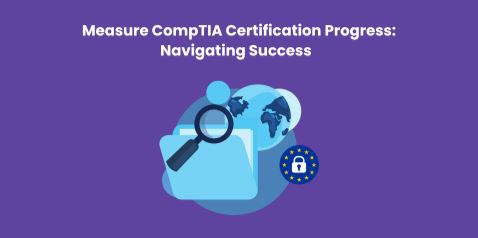
Any IT professional serious about climbing the corporate ladder should pursue certification from CompTIA. A CompTIA certification is a great addition to your resume because of its widespread acceptance and respect. However, the path to obtaining these credentials might be difficult, so it’s important to have a strategy in place for tracking your progress. In this blog, we will explore efficient methods for monitoring your progress along the CompTIA Certification Path, so that you may remain on track and reach your professional objectives. Let’s delve into CompTIA Course and certification status monitoring.
Table of contents
- The Significance of CompTIA Certifications
- CompTIA Certification Path
- How to Measure Progress on the CompTIA Certification Path
- Conclusion
The Significance of CompTIA Certifications
The Computing Technology Industry Association (CompTIA) provides certifications ranging from general IT skills to those in specific subfields of the IT industry. Companies throughout the globe value these qualifications highly, and many IT jobs won’t even consider applicants without them. The importance of CompTIA certifications may be broken down into the following categories:
- CompTIA certifications are highly recommended for IT professionals who want to operate in a variety of countries or for multinational organisations due to their widespread acceptance.
- Opportunities for Newcomers and Experienced Workers alike CompTIA certifications are appropriate for those at all stages of their careers. There is a CompTIA certification that is appropriate for your level of expertise, whether you are just starting in IT or are an established professional.
- CompTIA certifications are vendor-neutral in the sense that they do not favour one particular IT vendor over another. Because of this, they may be used in several occupations.
- Earning a CompTIA certification demonstrates that you have the necessary abilities and knowledge in a specific area of information technology. It demonstrates to prospective employers that you possess the requisite skills.
CompTIA Certification Path
The CompTIA certification route is a well-defined series of exams and badges that validate and improve your knowledge in certain areas of information technology. In most cases, it begins with basic qualifications and continues to more sophisticated ones. Take a look at this rundown of the most popular CompTIA credentials and the suggested sequence in which you earn them:
- If you’re new to the world of information technology, you should begin with CompTIA IT Fundamentals (ITF+).
- With CompTIA A+, you’ll learn the fundamentals of hardware, software, and troubleshooting in the IT industry. It’s a must-have credential for every IT worker.
- CompTIA Network+ covers advanced networking topics such as troubleshooting, security, and troubleshooting.
- Topics like cryptography, network security, and risk management are at the heart of the CompTIA Security+ curriculum.
- Anyone dealing with Linux-based systems should get their hands on the CompTIA Linux+ certification since it proves proficiency in Linux system management.
- It is important for IT professionals who deal with cloud infrastructure and services to be familiar with the concepts covered in CompTIA Cloud+.
- Those who manage servers will benefit greatly from taking CompTIA’s Server+ exam because of the exam’s emphasis on server hardware and management.
- You may improve your abilities to identify and counteract cybersecurity threats by earning the CompTIA CySA+ certification.
- CompTIA CASP+ is the highest level of certification offered by CompTIA; it focuses on enterprise-level security and advanced security solutions.
How to Measure Progress on the CompTIA Certification Path
Maintaining forward momentum towards your goal of earning your CompTIA certification requires a well-defined strategy and reliable metrics. Here are several methods to keep tabs on your development:
- Determine your professional aspirations and the credentials that will help you achieve them. Having well-defined goals will serve as a guidepost throughout your path to CompTIA certification.
- Think about how many hours a day or a week you can set out for studying. You may better organise your time and make steady progress with the aid of a regular study regimen.
- CompTIA allows candidates to test their knowledge via simulated tests. You may measure your knowledge and preparation for the real examinations by taking these practise tests at different stages of your trip.
- The CompTIA course texts, online courses, and study guides are all excellent investments. Studying the material here will prepare you well for the test.
- Time spent on each credential should be recorded. Keeping a record of the time you devote to studying is an excellent indicator of how seriously you take your studies.
- Get in touch with others who are also working towards their CompTIA certification via discussion boards, social media, or in-person meetups. Motivation and new ideas may be gained by hearing about other people’s experiences.
- Take exams to see how much you’ve learned at different stages of your studies. You may use this to pinpoint exactly what needs more attention.
- Find a teacher or mentor who is familiar with CompTIA certifications if you can. They are a great resource for guidance and encouragement.
- Make a strategy for when you will take each test and stick to it. A feeling of urgency and increased motivation may be achieved by setting hard deadlines.
- Rejoice in your success when you finally get that certification! Acknowledging your successes along the way might give you a confidence and motivation boost for the challenges ahead.
Conclusion
You may evaluate how well you’re doing by defining objectives, making a study plan, using study resources, and keeping track of your progress. The skills and expertise you demonstrate in the IT sector are reflected in your CompTIA certifications. Focus, keep going, and reward yourself for your progress along the way. The effort you put into earning your CompTIA credentials will be recognised and rewarded with better job chances in the IT industry.